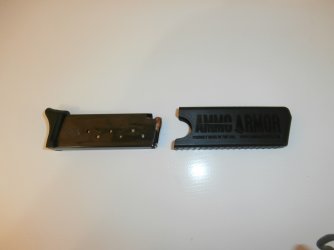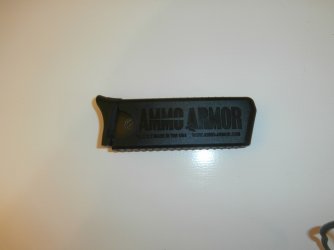JDMartin
Alpha
Spare mag(s)… DEFINITELY.
Granted FBI stats show most gun fights are typically less than 5 rds, one never knows what may come… or HOW MANY.
That said, I always recommend carrying an extra mag, and not just any old mag, but an extended mag at that, and here’s why.
I’m pretty sure most concealed carriers don’t have an extended mag inserted in the firearm while carrying as this presents a printing problem. But there’s NO-THING that says you can’t carry an extended mag or two as spares. Think about it… should you have to draw your weapon (God forbid) use it, and have to conduct a reload, why not give yourself every advantage possible and reload a 10 rd mag versus an 7 or 8 rd mag?
If you’ve drawn your weapon and emptied it the gig is up and at this point EVERYONE knows you’re carrying, so might as well load up a 10 rd mag. When carried properly .45 acp extended magazines don’t print anymore than standard 7 or 8 rd magazines. Hence I always opt for that extended mag as a spare, sometimes 2 depending on where I’m going.
And I throw the 8 rd spare mag in the truck for good measure.
One of the main knocks on the 1911 is the lack of ammunition with only 7-9 rds. And that’s fine because realistically I don’t feel as though I’m gonna need 16-18 rds to dispatch a would be bad guy. And if you want my honest opinion, anyone who does needs to shoot more, A LOT MORE with emphasis on shot placement.
That said, if I’m carrying 9 rds in the gun (8+1), and have two 10 rd spare mags, that’s a total of 29 rds. I mean unless we’re talking a zombie apocalypse or some other cataclysmic event, I sure as hell don’t anticipate needing 29 rds to dispatch a bad guy or two, or even three. Reload drills are important so practice them, a lot.
We all know shot placement is key. Hit a would be knucklehead anywhere in a vital region w/a 230 gr hollow point there’s a pretty good chance they’re gonna stop what they’re doing and lay down. Hit them twice and it’s game over.
Just sayin…
Granted FBI stats show most gun fights are typically less than 5 rds, one never knows what may come… or HOW MANY.
That said, I always recommend carrying an extra mag, and not just any old mag, but an extended mag at that, and here’s why.
I’m pretty sure most concealed carriers don’t have an extended mag inserted in the firearm while carrying as this presents a printing problem. But there’s NO-THING that says you can’t carry an extended mag or two as spares. Think about it… should you have to draw your weapon (God forbid) use it, and have to conduct a reload, why not give yourself every advantage possible and reload a 10 rd mag versus an 7 or 8 rd mag?
If you’ve drawn your weapon and emptied it the gig is up and at this point EVERYONE knows you’re carrying, so might as well load up a 10 rd mag. When carried properly .45 acp extended magazines don’t print anymore than standard 7 or 8 rd magazines. Hence I always opt for that extended mag as a spare, sometimes 2 depending on where I’m going.
And I throw the 8 rd spare mag in the truck for good measure.
One of the main knocks on the 1911 is the lack of ammunition with only 7-9 rds. And that’s fine because realistically I don’t feel as though I’m gonna need 16-18 rds to dispatch a would be bad guy. And if you want my honest opinion, anyone who does needs to shoot more, A LOT MORE with emphasis on shot placement.
That said, if I’m carrying 9 rds in the gun (8+1), and have two 10 rd spare mags, that’s a total of 29 rds. I mean unless we’re talking a zombie apocalypse or some other cataclysmic event, I sure as hell don’t anticipate needing 29 rds to dispatch a bad guy or two, or even three. Reload drills are important so practice them, a lot.
We all know shot placement is key. Hit a would be knucklehead anywhere in a vital region w/a 230 gr hollow point there’s a pretty good chance they’re gonna stop what they’re doing and lay down. Hit them twice and it’s game over.
Just sayin…


